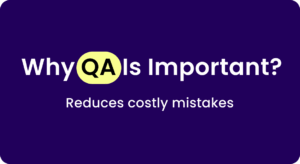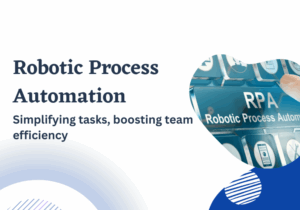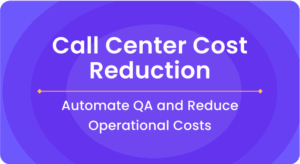Are you a business leader exploring the best speech analytics software solution for your sales calling team?
With so many options available in the market, you will soon face a plenty of problem while taking a decision.
But don’t worry, there’s a methodical and logical way to evaluate a speech analytics software, and that’s what we are going to discuss in this blog post today.
A. What is speech analytics?
Speech Analytics is the technique of analyzing recorded sales call or live conversation in order to extract useful insights and information.
This can be done through a variety of techniques, including keyword spotting, sentiment analysis, and conversation analysis.
Speech Analytics is usually used in sales and customer support to enhance the customer experience, close more deals, identify areas of improvement and improve CSAT and NPS score.
It is also used in a variety of other industries, such as fintech, finance, banking, healthcare, and retail.
B. Before you start the evaluation
1. Identify at least 1 primary use case
Before starting your journey to evaluate multiple speech analytics software available in the market, identify a problem within your calling process that you want to solve.
It can be saving manual effort during call QA, coaching the sales reps better, identifying recurring customer challenges or ensuring improved script compliance.
Whatever it may be, have at least 1 key business challenge handy with you.
During the course of your evaluation, the problem statement may change, or you may identify multiple secondary problem statements. That’s perfectly fine and natural.
Important is to get started with at least one main reason why you want to adopt a speech AI software.
2. Have a goal in mind
Once you have identified the business problem, set a goal that you want to achieve by solving that problem.
For e.g., you want to reduce the manual QA effort (by 50%), you want to coach the sales reps better (to improve revenue by at least 15%), you want to identify customer challenges (to reduce the churn by 40%) or you may want to improve script compliance (and reduce the chances of compliance failure by 90%).
Don’t worry if you can’t allot an exact number to your goal.
Idea is to have some benchmark in mind to ensure you can run the RoI calculations fast. That will help you take a faster decision.
3. Study the needs
Finally, combine the output of step 1 & 2 to build a list of your needs.
It’s not necessary that you will have your needs sorted out at the very start of the evaluation process.
In that case, initiate the conversations with vendors; talking about your business problem and the improvements you wish to achieve.
While you study the solutions available in the market, start framing your needs and refining them.
By the end of the process, you should have a clear list of your needs. That will make your decision making simple and easy.
For example, your goal is to save call QA time by X percentage. To achieve this goal, you would first want to replicate your calling theme within the software.
You would then want to create custom feedback forms, ability to write comments & notes; and share them with the agents. You may also want exhaustive call filtering to create test hypothesis.
Let’s now explore the most important parameters you should look at while evaluating a speech AI software
C. 7 critical parameters to evaluate a speech analytics software
1. Speech to text accuracy
At the heart of speech analytics technology lies the ability to convert voice calls into text data. Entire call analysis happens on the accuracy of the words that the AI algorithm pushes out.
We call it as STT (or speech to text) accuracy and it is represented as a simple percentage (e.g. 90%).
STT accuracy represents the fidelity of the software to convert voice data into words.
As a taxonomy, speech analytics software companies will have a universal AI model (or the base model) which is the starting point of voice analytics and ai lead scoring.
This universal model is then trained to improve accuracy of STT process.
Your first step to evaluate a speech analytics software should be to test the accuracy of the universal model.
During the evaluation phase, one of your first actions should be to ask for transcripts for a sample of your calls.
The accuracy of these transcripts should be your guiding point whether you want to continue the evaluation process or not.
A typical accuracy of 85% and beyond should be a good criteria to continue the discussion.
Caveat: It takes a lot of manual labor to calculate word by word accuracy, so an observation based evaluation should be good enough.
How Enthu.AI fares in STT accuracy?
Enthu.AI achieves a speech to text accuracy of as high as 95-97% for the best voice quality calls.
Our transcription algo uses the latest speech recognition techniques to achieve a transcription accuracy of more than 90%.
At Enthu.AI, we encourage all our prospects to provide us with call samples and test our transcription accuracy during the initial stages itself.
Not just that, we request the clients to include their best and worst calls (in terms of voice quality). This gives them a benchmark of the STT accuracy they can expect for their voice dataset.
As an example, here’s how you get the transcriptions within the platform.
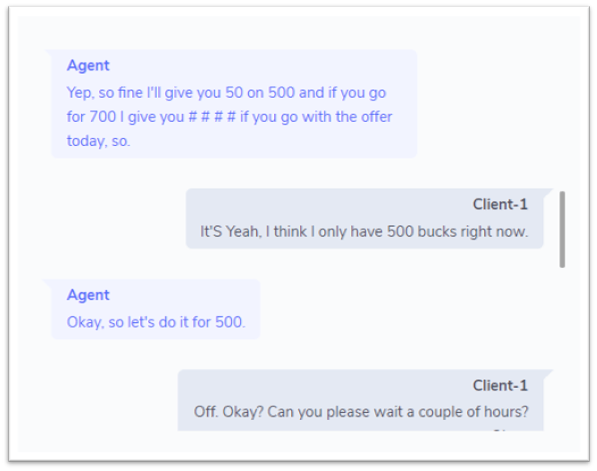
ALSO READ: Best Call Transcription Software
2. Integration(s) with your existing software
The conversation intelligence software that you wish to use should integrate with your VoIP/CRM/deal management software.
If there is no integration, don’t worry. Most of the providers will integrate with your business software on request.
However, ensure that you have a clear timeline and support commitments for the integration.
Understand the depth of the integration that the software provides. The most basic integration should be to automatically connect with your VoIP provider, pull out call recording data, run transcription & analysis; and present the final insights, without you lifting a finger.
More complex use cases can also be supported, like 2 way data exchange with your CRM, calendar integrations to pick call details and initiate recording automatically, and so on.
Understand your needs and look for integrations accordingly.
It’s not necessary that you will need complex integrations right at the very start. There’s no point paying extra for complexity that you are not going to use. So judge accordingly.
Moreover, whether a speech analytics software integrates with your 3rd party software or not, always take an upfront support commitment, especially for the onboarding stage.
Integrations Enthu.AI supports
Enthu.AI integrates with multiple VoIP, CRM and web conference solutions, especially the popular ones.
However, we do accept that we may not be integrated with all the 3rd party systems. If that’s the case, we let the customer know in advance. As the engagement progresses towards finalization, we build the integration for you so that you can get started at the earliest.

3. Onboarding & ongoing support
Implementing software is always easy; making people adopt it is the real task.
It might take a couple of months before you settle with a speech analytics software. In this period, your team might face technical challenges, will need training support, will ask for software demos; and so on.
You need to ensure you get impeccable support from your vendor, not just to get started with but also on an ongoing basis.
Give preference to a vendor that offers unlimited free support, preferably a dedicated account manager.
This becomes even more critical when you are running a decent size setup and need someone to look into your issues urgently.
Onboarding support you get with Enthu.AI
Once you onboard with Enthu.AI, you get a dedicated account manager to handle all your queries, questions and concerns.
Our account managers also play the role of a customer success representative. That means their job is to make you successful, no matter what. You get dedicated access to the account manager right from the day you onboard , till your journey with Enthu.AI continues.
4. Availability of feature set
No matter the software, you are not going to get the best of all the worlds. You might love the feedback module within tool A, collaboration features of tool B, integration capabilities of tool C and real time transcription option of tool D.
If that’s the case, you will soon end up with data overload and decision paralysis.
Be aware of the problem you intend to solve with conversation analytics, and then map the features against your needs.
It may happen that a software with million features may not be a good fit and you are paying for bells and whistles, instead of the essentials.
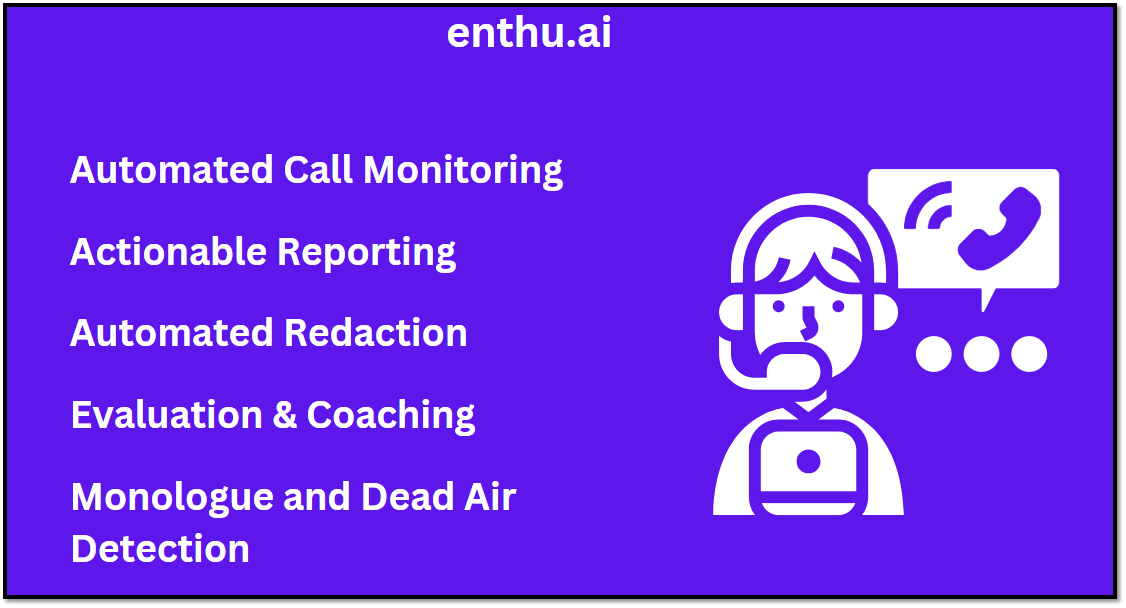
If you are confused over the feature set, do a mapping of the features aginst their ability to solve your problem.
Mark them as must haves, good to haves and irrelevant, depending on your use case.
For example, analyzing a call across critical moments, downloading the transcript and sharing call feedback may be critical for you, while creating a call playlist for sharing with teams might be completely irrelevant.
This exercise will ensure you are considering the right feature set without getting overwhelmed with the bells and whistles.
Take help from the software vendor. We talk to customers day in and day out, and we know what’s essential for you.
How Enthu.AI helps you run a mapping exercise?
Enthu.AI is built for calling teams across functions: be it sales, support or customer success at BPOs, SaaS companies or any other industry.
At Enthu.AI, we pride ourselves in being a software that doesn’t drown you in data or features.
We adopt a simplistic approach to speech analytics that’s designed to do the job in the least complicated way, without overwhelming the end user.
Having said that, Enthu.AI comes with a host of features suited for all the target roles & use cases specified above.
Not just that, when you initiate a conversation with our team, our very first objective is to understand your use case and map these features according to the problem you intend to solve.
That means you get free consulting to understand which features to look out for while you evaluate multiple voice analytics products in the market.
5. Option for discount/free pilots
The best way to try out a software and its features is to opt for its free plan.
Ensure you are not paying anything for the trial period, it should be 100% free (may be with limitations, but that should be fine).
Use the free trial period to evaluate the software end to end.
That’s when you will truly identify the features that you can’t live without.
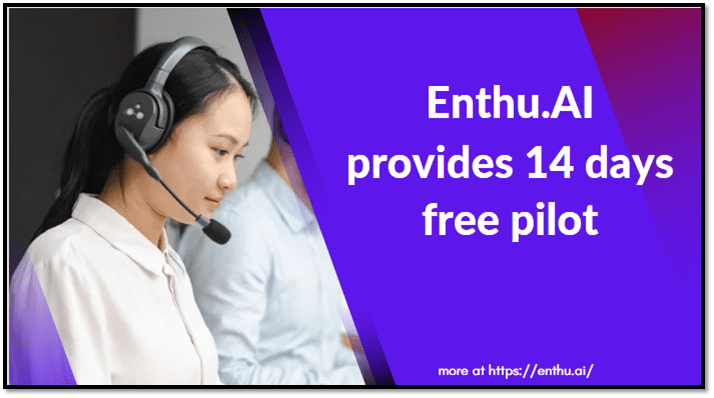
We work with your team closely during the free trial period, setting up the system and helping you visualize your use case.
At the end of the free trial period, you can walk away without any obligation or you can sign up for a paid plan, it’s totally your decision.
6. One time and recurring pricing
If you are looking for a cloud based solution, the majority of the alternatives in the market don’t charge any setup or one time fee.
They all charge a recurring fee, payable per agent per month/per annum. This pricing can remain the same irrespective of the usage of the system, or can vary based on your calling volume at your organization.
Irrespective of the pricing, a better mechanism to evaluate a software should be the return on investment (RoI) that you anticipate to generate.
Cheap is not always bad and expensive is not always great. You should identify the value that you intend to derive from the tool, and then look at the asking price.
You should also include your and the team’s time investment as part of the RoI calculation.
That should be the sole judgement criteria when it comes to commercials.
Always check the finer details around the pricing. Don’t hesitate to ask for volume discounts, based on the number of calling agents you have.
Also, most of the tools offer custom pricing based on your needs.
Remember that a blanket pricing may not be suitable for you and you should discuss that with the provider during the evaluation stage.
How is Enthu.AI priced?
Our recurring price is also fairly simple: we charge you per agent per month basis, with discounts billed when you pay annual (you have an option to pay semi annual as well).
You can start with min 10 agents and scale up based on your needs.
7. Compare contractual commitments
The beauty of SaaS is that you can start and stop anytime you wish.
Moreover, conversation intelligence as a concept is still new and the majority of the companies have to experiment and fine tune before they reach the intended stage.
In such a scenario, understand the upfront contractual obligations that a speech analytics software provider demands from you.
I don’t want to be a pessimist here, but it’s a possibility that your software implementation may not be successful.
Everything may be perfect and still it can fail: may be your operational managers are not bought into the concept of a machine listening to the calls , or the top management is not giving it the right push, or your processes are too complicated to fit in a speech analytics software.
That’s why, prefer a vendor that doesn’t tie you up in unnecessary obligations.
These obligations can be towards compulsorily subscribing to an annual plan upfront.
Avoiding contractual obligations is even more necessary for small and medium businesses that want to experiment without blocking their capital, at the same time don’t want to get stuck with a vendor just in case the implementation is not successful.
Enthu.AI is a “NO commitment required” call center software.
At Enthu.AI, we understand that most of the customers exploring a speech analytics solution want to start small before they fully commit to the idea.
We don’t bind you in annual contracts, though we offer discounts if you decide to chose one.
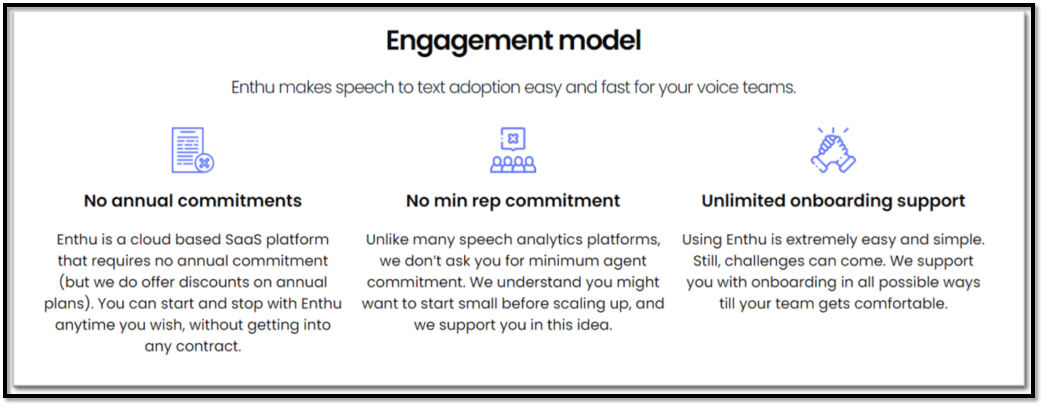
In short, Enthu.AI should be your choice if you want a voice analytics software with less obligations.
D. Difference between speech recognition and transcription
Here are some key differences between speech analytics and transcription:
1 Purpose
Speech analytics is used to extract valuable insights and information from spoken language data, such as customer service calls or meetings. It can be used to improve customer service, identify sales opportunities, or detect potential fraud.
Transcription, on the other hand, is used to convert audio or video recordings of spoken language into written text. The goal is to produce an accurate written record of the spoken words.
2. Technologies used
Speech analytics uses advanced technologies such as natural language processing (NLP) and machine learning (ML) to automatically analyze and understand spoken language.
Transcription can be done either by human transcribers or by using speech recognition software, which uses similar technologies as speech analytics but with a focus on converting speech to text.
3. Output
The output of speech analytics is typically a report or summary of key insights and information, such as the frequency of certain words or phrases, or the sentiment of the speakers.
The output of transcription is a written text version of the audio or video recording of the speech.
Therefore, speech analytics is focused on extracting insights and information from spoken language data, while transcription is focused on converting spoken language into a written text format. Both technologies use similar techniques but have different end goals.
Conclusion
You are definitely on your way to growth if you are considering a conversation intelligence software.
However, like any other software, there are so many options in the market that you will soon face a challenge to make the right decision.
Considering the above 7 parameters while evaluating a speech analytics software will ensure you take the right decision.
If you think there are more important evaluation parameters that can be added to the list (we are sure there will be more), do comment below.
FAQs
1. What are speech analytics tools?
Speech analytics tools use advanced technologies such as natural language processing and machine learning to automatically analyse spoken language data and extract valuable insights and information.
2. What are the benefits of speech analytics?
Speech analytics provides actionable insights to enhance customer experience, improve agent performance, reduce operational costs, and increase revenue. It can identify areas for process improvement, detect compliance issues, and monitor customer sentiment.
3. What is speech to text analytics?
Speech to text analytics is a technology that transcribes spoken words into written text, allowing speech-based interactions to be analyzed and understood by machines. It is used to automate speech-based data processing, enhance search capabilities, and improve accessibility.

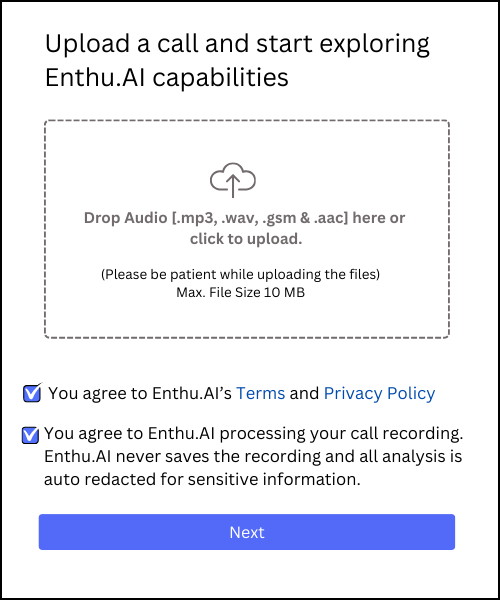



 On this page
On this page
